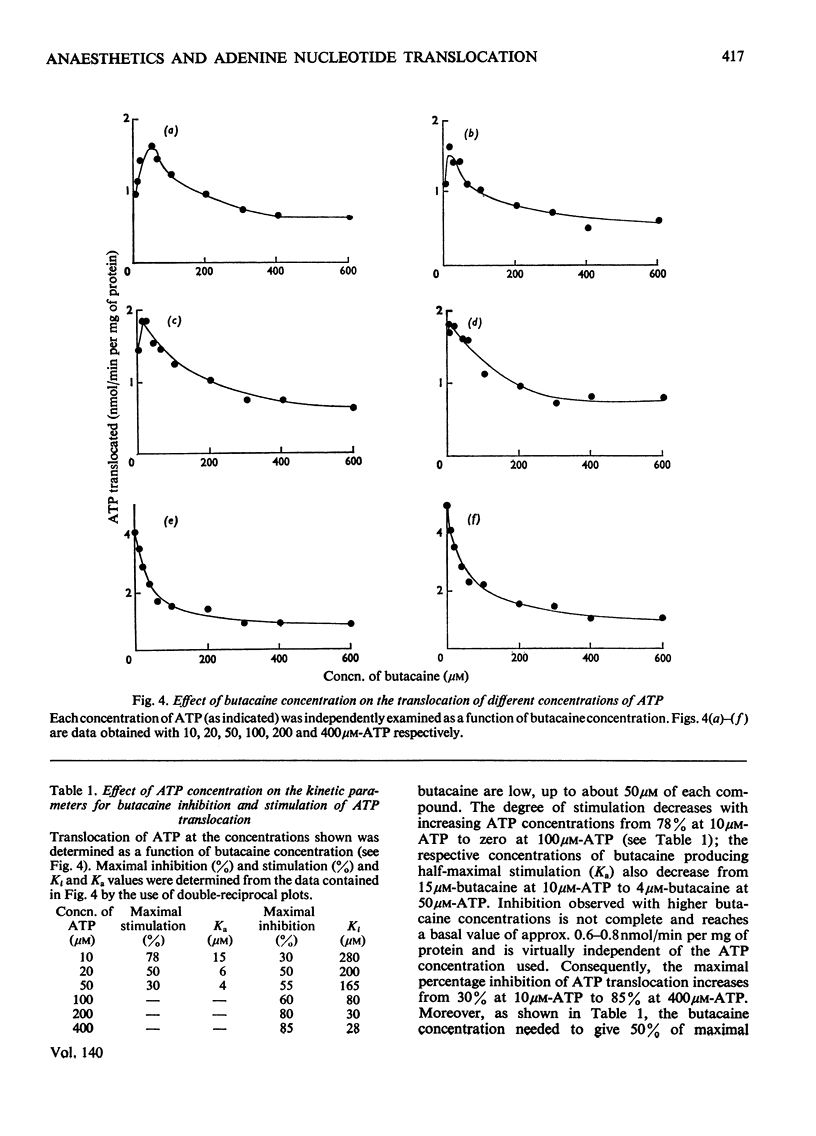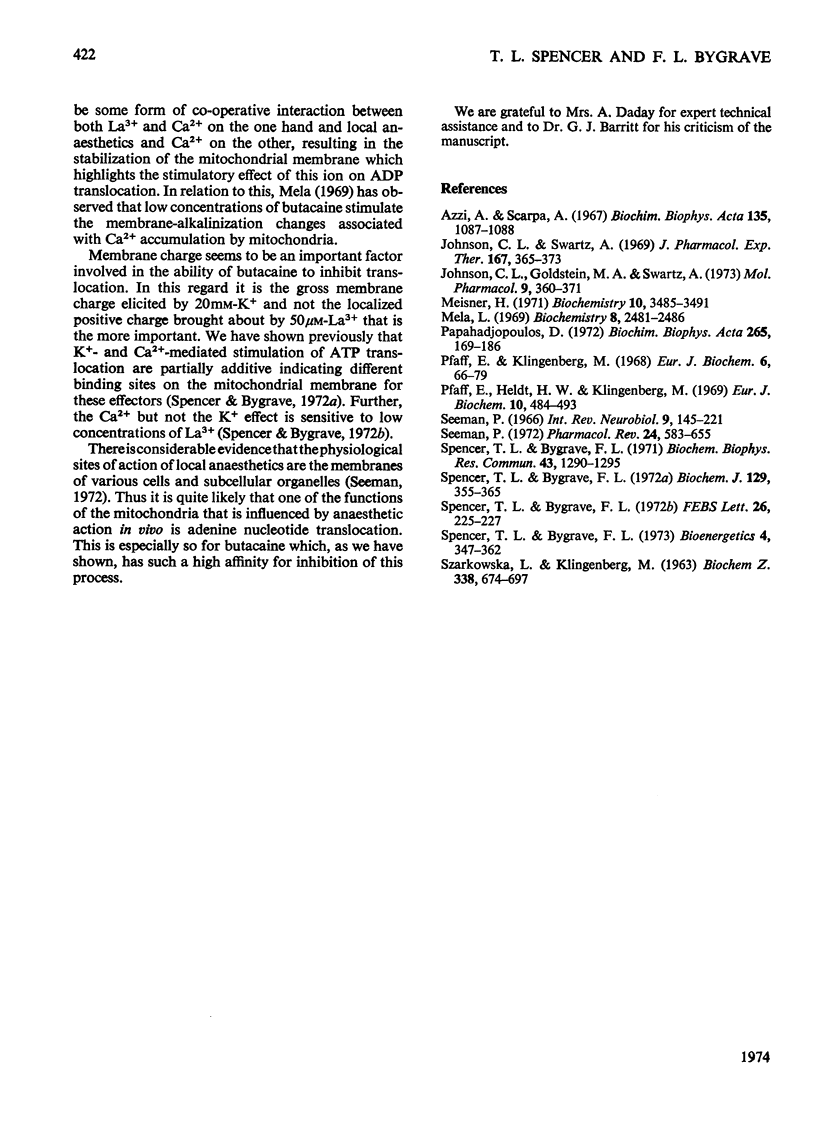Abstract
1. The mechanism of adenine nucleotide translocation in mitochondria isolated from rat liver was further examined by using the local anaesthetics procaine, butacaine, nupercaine and tetracaine as perturbators of lipid–protein interactions. Each of these compounds inhibited translocation of ADP and of ATP; butacaine was the most effective with 50% inhibition occurring at 30μm for 200μm-ATP and at 10μm for 200μm-ADP. The degree of inhibition by butacaine of both adenine nucleotides was dependent on the concentration of adenine nucleotide present; with low concentrations of adenine nucleotide, low concentrations of butacaine-stimulated translocation, but at high concentrations (greater than 50μm) low concentrations of butacaine inhibited translocation. Butacaine increased the affinity of the translocase for ATP to a value which approached that of ADP. 2. Higher concentrations of nupercaine and of tetracaine were required to inhibit translocation of both nucleotides; 50% inhibition of ATP translocation occurred at concentrations of 0.5mm and 0.8mm of these compounds respectively. The pattern of inhibition of ADP translocation by nupercaine and tetracaine was more complex than that of ATP; at very low concentrations (less than 250μm) inhibition ensued, followed by a return to almost original rates at 1mm. At higher concentrations inhibition of ADP translocation resulted. 3. That portion of ATP translocation stimulated by Ca2+ was preferentially inhibited by each of the local anaesthetics tested. In contrast, inhibition by the anaesthetics of ADP translocation was prevented by low concentrations of Ca2+. 4. The data provide further support for our hypothesis that lipid–protein interactions are important determinants in the activity of the adenine nucleotide translocase in mitochondria.
Full text
PDF









Selected References
These references are in PubMed. This may not be the complete list of references from this article.
- Azzi A., Scarpa A. Inhibition of K+ transport in liver mitochondria. Biochim Biophys Acta. 1967;135(5):1087–1088. doi: 10.1016/0005-2736(67)90085-5. [DOI] [PubMed] [Google Scholar]
- Johnson C. L., Goldstein M. A., Schwartz A. On the molecular action of local anesthetics. 1. The mitochondrian as a model membrane system for studying local anesthetic action. Mol Pharmacol. 1973 May;9(3):360–371. [PubMed] [Google Scholar]
- Johnson C. L., Schwartz A. Some effects of local anesthetics on isolated mitochondria. J Pharmacol Exp Ther. 1969 Jun;167(2):365–373. [PubMed] [Google Scholar]
- Meisner H. Control of adenine nucleotide exchange in mitochondria by cations and protons. Biochemistry. 1971 Sep 14;10(19):3485–3491. doi: 10.1021/bi00795a001. [DOI] [PubMed] [Google Scholar]
- Mela L. Inhibition and activation of calcium transport in mitochondria. Effect of lanthanides and local anesthetic drugs. Biochemistry. 1969 Jun;8(6):2481–2486. doi: 10.1021/bi00834a034. [DOI] [PubMed] [Google Scholar]
- Papahadjopoulos D. Studies on the mechanism of action of local anesthetics with phospholipid model membranes. Biochim Biophys Acta. 1972 Apr 18;265(2):169–186. doi: 10.1016/0304-4157(72)90001-9. [DOI] [PubMed] [Google Scholar]
- Pfaff E., Heldt H. W., Klingenberg M. Adenine nucleotide translocation of mitochondria. Kinetics of the adenine nucleotide exchange. Eur J Biochem. 1969 Oct;10(3):484–493. doi: 10.1111/j.1432-1033.1969.tb00715.x. [DOI] [PubMed] [Google Scholar]
- Pfaff E., Klingenberg M. Adenine nucleotide translocation of mitochondria. 1. Specificity and control. Eur J Biochem. 1968 Oct 17;6(1):66–79. doi: 10.1111/j.1432-1033.1968.tb00420.x. [DOI] [PubMed] [Google Scholar]
- SZARKOWSKA L., KLINGENBERG M. ON THE ROLE OF UBIQUINONE IN MITOCHONDRIA. SPECTROPHOTOMETRIC AND CHEMICAL MEASUREMENTS OF ITS REDOX REACTIONS. Biochem Z. 1963;338:674–697. [PubMed] [Google Scholar]
- Seeman P. M. Membrane stabilization by drugs: tranquilizers, steroids, and anesthetics. Int Rev Neurobiol. 1966;9:145–221. doi: 10.1016/s0074-7742(08)60138-5. [DOI] [PubMed] [Google Scholar]
- Seeman P. The membrane actions of anesthetics and tranquilizers. Pharmacol Rev. 1972 Dec;24(4):583–655. [PubMed] [Google Scholar]
- Spencer T., Bygrave F. L. Modification by calcium ions of adenine nucleotide translocation in rat liver mitochondria. Biochem J. 1972 Sep;129(2):355–365. doi: 10.1042/bj1290355. [DOI] [PMC free article] [PubMed] [Google Scholar]
- Spencer T., Bygrave F. L. Stimulation by calcium ions of atractyloside-sensitive adenine nucleotide translocation in rat liver mitochondria. Biochem Biophys Res Commun. 1971 Jun 18;43(6):1290–1295. doi: 10.1016/s0006-291x(71)80012-8. [DOI] [PubMed] [Google Scholar]
- Spencer T., Bygrave F. L. The influence of lanthanum on calcium-stimulated ATP translocation in rat liver mitochondria. FEBS Lett. 1972 Oct 1;26(1):225–227. doi: 10.1016/0014-5793(72)80578-7. [DOI] [PubMed] [Google Scholar]
- Spencer T., Bygrave F. L. The role of mitochondria in modifying the cellular ionic environment: studies of the kinetic accumulation of calcium by rat liver mitochondria. J Bioenerg. 1973 Apr;4(3):347–362. doi: 10.1007/BF01648977. [DOI] [PubMed] [Google Scholar]


